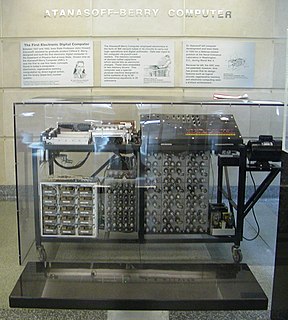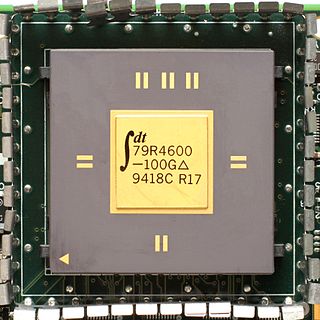Processor design is the design engineering task of creating a processor, a component of computer hardware. It is a subfield of computer engineering and electronics engineering (fabrication). The design process involves choosing an instruction set and a certain execution paradigm and results in a microarchitecture, which might be described in e.g. VHDL or Verilog. For microprocessor design, this description is then manufactured employing some of the various semiconductor device fabrication processes, resulting in a die which is bonded onto a chip carrier. This chip carrier is then soldered onto, or inserted into a socket on, a printed circuit board (PCB).
MIPS is a reduced instruction set computer (RISC) instruction set architecture (ISA) developed by MIPS Computer Systems.
SuperH is a 32-bit reduced instruction set computing (RISC) instruction set architecture (ISA) developed by Hitachi and currently produced by Renesas. It is implemented by microcontrollers and microprocessors for embedded systems.
The Intel i860 was a RISC microprocessor design introduced by Intel in 1989. It was one of Intel's first attempts at an entirely new, high-end instruction set architecture since the failed Intel iAPX 432 from the 1980s. It was released with considerable fanfare, slightly obscuring the earlier Intel i960, which was successful in some niches of embedded systems, and which many considered to be a better design. The i860 never achieved commercial success and the project was terminated in the mid-1990s.

A digital signal processor (DSP) is a specialized microprocessor, with its architecture optimized for the operational needs of digital signal processing.

Instruction-level parallelism (ILP) is a measure of how many of the instructions in a computer program can be executed simultaneously.
Loongson is a family of general-purpose MIPS64 CPUs developed at the Institute of Computing Technology (ICT), Chinese Academy of Sciences (CAS) in China. The chief architect is Professor Hu Weiwu. It was formerly called Godson.

Joseph A "Josh" Fisher is an American and Spanish computer scientist noted for his work on VLIW architectures, compiling, and instruction-level parallelism, and for the founding of Multiflow Computer. He is a Hewlett-Packard Senior Fellow (Emeritus).
In computer architecture, a transport triggered architecture (TTA) is a kind of processor design in which programs directly control the internal transport buses of a processor. Computation happens as a side effect of data transports: writing data into a triggering port of a functional unit triggers the functional unit to start a computation. This is similar to what happens in a systolic array. Due to its modular structure, TTA is an ideal processor template for application-specific instruction-set processors (ASIP) with customized datapath but without the inflexibility and design cost of fixed function hardware accelerators.
The Fujitsu FR-V is one of the very few processors ever able to process both a very long instruction word (VLIW) and vector processor instructions at the same time, increasing throughput with high parallel computing while increasing performance per watt and hardware efficiency. The family was presented in 1999. Its design was influenced by the VPP500/5000 models of the Fujitsu VP/2000 vector processor supercomputer line.

The POWER3 is a microprocessor, designed and exclusively manufactured by IBM, that implemented the 64-bit version of the PowerPC instruction set architecture (ISA), including all of the optional instructions of the ISA such as instructions present in the POWER2 version of the POWER ISA but not in the PowerPC ISA. It was introduced on 5 October 1998, debuting in the RS/6000 43P Model 260, a high-end graphics workstation. The POWER3 was originally supposed to be called the PowerPC 630 but was renamed, probably to differentiate the server-oriented POWER processors it replaced from the more consumer-oriented 32-bit PowerPCs. The POWER3 was the successor of the P2SC derivative of the POWER2 and completed IBM's long-delayed transition from POWER to PowerPC, which was originally scheduled to conclude in 1995. The POWER3 was used in IBM RS/6000 servers and workstations at 200 MHz. It competed with the Digital Equipment Corporation (DEC) Alpha 21264 and the Hewlett-Packard (HP) PA-8500.

The R10000, code-named "T5", is a RISC microprocessor implementation of the MIPS IV instruction set architecture (ISA) developed by MIPS Technologies, Inc. (MTI), then a division of Silicon Graphics, Inc. (SGI). The chief designers are Chris Rowen and Kenneth C. Yeager. The R10000 microarchitecture is known as ANDES, an abbreviation for Architecture with Non-sequential Dynamic Execution Scheduling. The R10000 largely replaces the R8000 in the high-end and the R4400 elsewhere. MTI was a fabless semiconductor company; the R10000 was fabricated by NEC and Toshiba. Previous fabricators of MIPS microprocessors such as Integrated Device Technology (IDT) and three others did not fabricate the R10000 as it was more expensive to do so than the R4000 and R4400.

The R5000 is a microprocessor that implements the MIPS IV instruction set architecture (ISA) developed by Quantum Effect Design (QED). The project was funded by MIPS Technologies, Inc (MTI), also the licensor. MTI then licensed the design to Integrated Device Technology (IDT), NEC, NKK, and Toshiba. The R5000 succeeded the QED R4600 and R4700 as their flagship high-end embedded microprocessor. IDT marketed its version of the R5000 as the 79RV5000, NEC as VR5000, NKK as the NR5000, and Toshiba as the TX5000. The R5000 was sold to PMC-Sierra when the company acquired QED. Derivatives of the R5000 are still in production today for embedded systems.
PRISM was Apollo Computer's high-performance CPU used in their DN10000 series workstations. It was for some time the fastest microprocessor available, a high fraction of a Cray-1 in a workstation. Hewlett Packard purchased Apollo in 1989, ending development of PRISM, although some of PRISM's ideas were later used in HP's own HP-PA Reduced instruction set computer (RISC) and Itanium processors.
Advanced Vector Extensions are extensions to the x86 instruction set architecture for microprocessors from Intel and AMD proposed by Intel in March 2008 and first supported by Intel with the Sandy Bridge processor shipping in Q1 2011 and later on by AMD with the Bulldozer processor shipping in Q3 2011. AVX provides new features, new instructions and a new coding scheme.

The R4600, code-named "Orion", is a microprocessor developed by Quantum Effect Design (QED) that implemented the MIPS III instruction set architecture (ISA). As QED was a design firm that did not fabricate or sell their designs, the R4600 was first licensed to Integrated Device Technology (IDT), and later to Toshiba and then NKK. These companies fabricated the microprocessor and marketed it. The R4600 was designed as a low-end workstation or high-end embedded microprocessor. Users included Silicon Graphics, Inc. (SGI) for their Indy workstation and DeskStation Technology for their Windows NT workstations. The R4600 was instrumental in making the Indy successful by providing good integer performance at a competitive price. In embedded systems, prominent users included Cisco Systems in their network routers and Canon in their printers.
Fermi is the codename for a GPU microarchitecture developed by Nvidia, first released to retail in April 2010, as the successor to the Tesla microarchitecture. It was the primary microarchitecture used in the GeForce 400 series and GeForce 500 series. It was followed by Kepler, and used alongside Kepler in the GeForce 600 series, GeForce 700 series, and GeForce 800 series, in the latter two only in mobile GPUs. In the workstation market, Fermi found use in the Quadro x000 series, Quadro NVS models, as well as in Nvidia Tesla computing modules. All desktop Fermi GPUs were manufactured in 40 nm, mobile Fermi GPUs in 40 nm and 28 nm. Fermi is the oldest microarchitecture from NVIDIA that received support for the Microsoft's rendering API Direct3D 12 feature_level 11.










